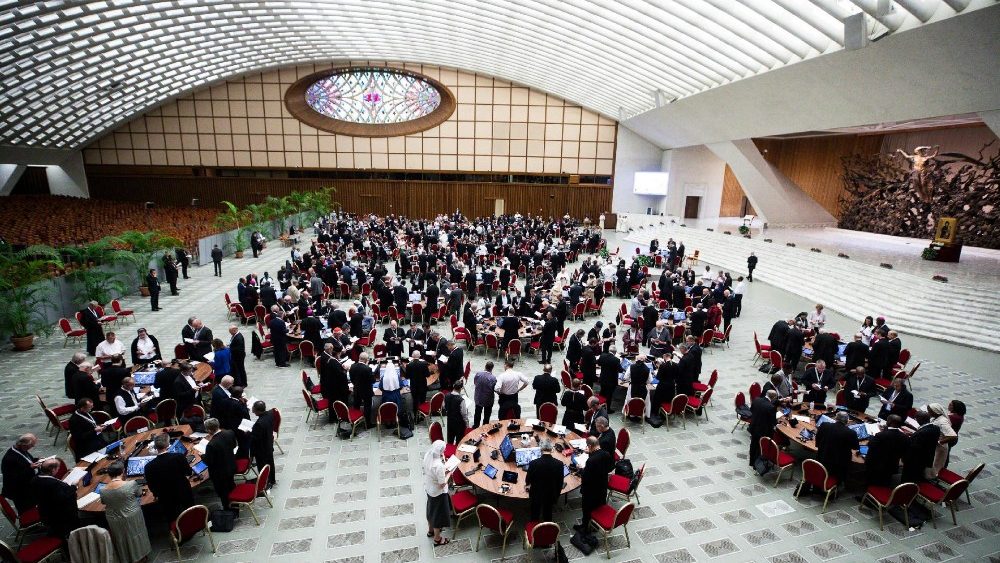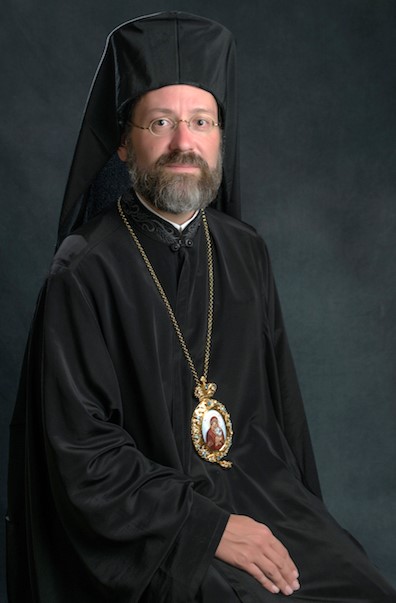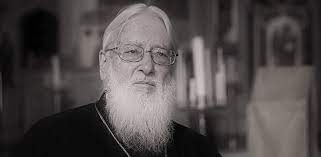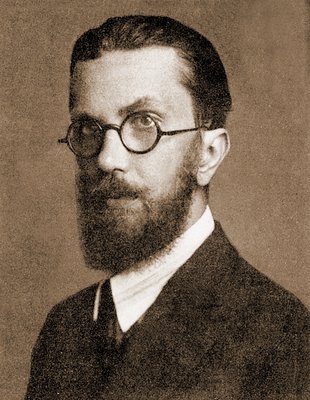
A session of the Synod on Synodality (link) now meeting in Rome from October 4 to October 29. This is the 16th bishops’ synod since the Bishops’ Synod was established as a new office in the Vatican by Pope Paul VI in 1965 (link)
The gathering of more than 350 delegates from around the world, including bishops, priests, religious, and laymen and laywomen, is taking place in the Paul VI Audience Hall inside Vatican City. Most sessions involve discussions in small groups seated around tables of 12 people. It is a “Synod of Bishops,” but not only bishops are participating and voting — something new in the Catholic Church. Up until this year, only bishops have had the possibility of casting a vote. Here, as background, is the schedule of the synod and a list of the participants (link).
Below, a photo of Metropolitan Job of Pisidia, 49 (born Ihor Wladimir Getcha, January 31, 1974). He is an Eastern Orthodox Metropolitan of the Ecumenical Patriarchate of Constantinople who is the Permanent Representative of the Ecumenical Patriarchate to the World Council of Churches and the Dean of the Institute for Orthodox Theology Higher Studies at Chambésy, Switzerland. He was the Archbishop of Telmessos and was elected on July 22, 2022, as the new metropolitan of Pisidia. On October 9 at the Synod in Rome, he gave a brief reflection of the meaning of synodality for the Orthodox Church (full text below)


The late Metropolitan Kallistos Ware (link) a leading Orthodox theologian who taught at Oxford and died a year ago at the age of 87. He was one of the best-known modern Orthodox theologians. He wrote in a profound way about synodality and Church government, seeking in the synodal process always its inner Eucharistic dimension…

Archpriest Georges Vasilievich Florovsky, 9 September [O.S. 28 August] 1893-August 11, 1979) was a Russian Orthodox priest, theologian, and historian. Born in the Russian Empire, he spent his working life in Paris (1920-1949) and New York (1949–1979). With Sergei Bulgakov, Vladimir Lossky, Justin Popović and Dumitru Stăniloae he was one of the more influential Eastern Orthodox Christian theologians of the mid-20th century. He was particularly concerned that modern Christian theology might receive inspiration from the lively intellectual debates of the patristic traditions of the undivided Church rather than from later Scholastic or Reformation categories of thought. He wrote a profound essay on the Orthodox view of synodality which deserves to be read, if you have time (link). Below is an extract from this work. See also (link)
“In light of this, we could say that the understanding of synodality in the Orthodox Church differs greatly from the definition of synodality given by your present assembly of the Synod of Bishops.” —Orthodox Metropolitan Job of Pisidia, addressing the Synod on Synodality on October 9, 2023, in Rome
Letter #140, 2023, Friday, October 13: Orthodox Bishop Job of Pisidia on Synodality in the Orthodox tradition
The holding of Synods of Bishops has been, over the centuries, the common way, in the Orthodox Christian world, for decisions to be taken by the leadership of the Church. Here is a link to a marvelous reflection on this aspect of ecclesial life by the late Orthodox Bishop Kallistos Ware, who taught at Oxford, entitled “Synodality and Primacy in the Orthodox Church,” in a talk delivered on January 12, 2019. He died on August 24, 2022, in Oxford. (link)
In his talk, Ware emphasizes that teaching authority, and canonical authority, in the Church is deeply marked by the Eucharist, the sacrament of the presence of Jesus Christ in our world, here and now.
“It is the Eucharist that holds the Church together and makes it one body in Christ,” Ware writes. “Ecclesial unity is not imposed from above by power of jurisdiction, but it is created from within by communion in the sacramental Body and Blood of the risen Christ.” Due to this “liturgical aspect,” he said, synodality and primacy are to be understood “primarily in a mysterial and sacramental context.”
The restoration of regular bishops’ synods in the Roman Catholic Church, instituted by Paul VI on September 15, 1965 just before the close of the Second Vatican Council (link) has therefore been seen by Catholic leaders as a way of reaching out to the Orthodox — to indicate to the Orthodox that the Catholic Church is open to and respectful of the idea of including more “synodality” (“collegiality,” we might also say) in its own decision-making processes, and in this way to embrace and to honor the Orthodox tradition, in an ecumenical sense, drawing Catholics and Orthodox closer together in view of eventually overcoming nearly 1,000 years of separation (from the Great Schism of 1054 A.D., in which the Pope of Rome and the Patriarch of Constantinople — “New Rome” — mutually excommunicated one another, bringing about the split between the Catholic and the Orthodox Churches that has not yet been overcome).
However, the inclusion of non-bishops in the deliberations of this present Synod, including in voting, is not a part of the Orthodox tradition.
So this Synod has a certain ambivalent character in regard to closer relations with the Orthodox.
The Orthodox do appreciate the Catholic embrace of the idea of “synodality” as a way to reach Church decisions.
However, they also find this particular type of Synod, with its un-traditional voting by non-bishops, as problematic.
This concern was expressed publicly, in a kind and thoughtful way, by a leading Orthodox bishop, Metropolitan Job of Pisidia, in an address he made to the gathering on October 9.
The full text of Bishop Job’s address is below.
It seems important to keep in mind this “double effect” of having a “Synod on Synodality” which
(1) opens the decision-making process of the Catholic Church toward the process as it traditionally has occurred in Orthodoxy, but
(2) at the same time, alters a distinctive element of that synodal process, so raising concerns at the very moment that it offers hope of closer union.—RM
***
Metropolitan Job of Pisidia to Synod on Synodality: “A Synod is a deliberative meeting of bishops, not a consultative clergy-laity assembly” (link)
By Metropolitan Job (Getcha)
Vatican City, October 9, 2023
Synod: Testimony of Metropolitan of Job (Getcha) of Pisidia
At the presentation of the Fourth General Congregation of the Synod, Metropolitan Job (Getcha) of Pisidia, Co-President of the Joint International Commission for Theological Dialogue between the Catholic Church and the Orthodox Church, offers a reflection on the experience of synodality in the Orthodox Church.
Intervention of His Eminence Metropolitan of Pisidia Job (Getcha)
XVI General Ordinary Assembly of the Synod of Bishop
Vatican, 9 October 2023
Your Holiness,
Dear Brothers and Sisters in Christ,
Above all, I would like to express my gratitude for the honor granted to the Orthodox Church to participate in this Synod of Bishops, and to the first throne of Orthodoxy, the Ecumenical Patriarchate, to be represented here, and to be able to express itself to bear witness to the practice of synodality in the Orthodox Church.
For the Orthodox, synodality corresponds to the practice established by the first ecumenical council (Nicea, 325) of gathering the bishops of a region at least twice a year under the presidency of their protos (cf. canon 5). This synodality is best described by Apostolic Canon 34:
“The bishops of the people of a province or region [ethnos] must recognize the one who is first [protos] amongst them, and consider him to be their head [kephale], and not do anything important without his consent [gnome]; each bishop may only do what concerns his own diocese [paroikia] and its dependent territories. But the first [protos] cannot do anything without the consent of all. For in this way concord [homonoia] will prevail, and God will be praised through the Lord in the Holy Spirit”.
Thus, in light of this text, it appears that:
1) A synod is a deliberative meeting of bishops, not a consultative clergy-laity assembly.
2) There cannot be a synod without a primate/protos, and there cannot be a primate/protos without a synod.
3) The primate/protos is part of the synod; he does not have superior authority to the synod, nor is he excluded from it.
4) The concord/homonoia which is expressed through the synodal consensus reflects the Trinitarian mystery of the divine life.
It is through this practice of synodality, as described by the Apostolic Canons and the canons of the First Ecumenical Council, that the Orthodox Church has been administered over the centuries until the present day, although the frequency and constitution of the synods may vary from one local autocephalous Church to another.
In light of this, we could say that the understanding of synodality in the Orthodox Church differs greatly from the definition of synodality given by your present assembly of the Synod of Bishops.
Nevertheless, it should be admitted that in certain historical circumstances the Orthodox Church has involved the clergy and laity in synodal decision-making. In the Ottoman empire, the election of Primates was carried out by clergy-laity assemblies. In the 17th century, the Ecumenical Patriarchate prescribed that the Metropolitan of Kiev be elected by a clergy-laity assembly in Kiev. Two centuries later, in Russia, the Slavophiles, inspired by the theology of communio of the Tübingen school, forged the concept of sobornost, wanting to involve all the components of the Church in its administration. This culminated at the beginning 20th century in the local council of the Church of Russia (Moscow, 1917-1918) which proposed that ecclesial decisions be taken by a council (sobor) consisting of representatives of the episcopate, clergy, monks and laity. Nevertheless, the Bolshevik revolution did not allow the implementation of this new mode of administration in the Church. However, in the Church of Cyprus, until today, bishops are elected not exclusively by the episcopate, but also by the clergy and the laity: at the first stage, the entire population of the Island votes from the list of all the candidates, then, in a second step, the synod of bishops chooses one from the three candidates having obtained the majority of votes.
Nevertheless, the case of the Church of Cyprus constitutes an exceptional case in contemporary Orthodoxy, where, otherwise, the practice of synodality implies exclusively an assembly of bishops. Thus, the Holy and Great Council (Synod) of the Orthodox Church which gathered in Crete in 2016 was made up of 162 delegated bishops, while the 62 advisors (clergy, monastics and laity) that were present did not have the right neither to speak, nor to vote.
Thank you for your attention!
+Metropolitan Job of Pisidia
***
Note: Here is a list (in Italian, but you should be able to easily understand most of the names and denominations) of the “fraternal delegates” present at the Synod on Synodality — members of other Churches, not Catholics, who are observing the proceedings.
DELEGATI FRATERNI (“Fraternal Delegates”)
Patriarcato Ecumenico
– Sua Eminenza JOB (Getcha), Metropolita di Pisidia, Copresidente della Commissione mista internazionale di dialogo teologico tra la Chiesa cattolica e la Chiesa ortodossa
Chiesa ortodossa serba
– Sua Ecc.za NEKTARIJE (Samardžić), Vescovo di Jegar, Vicario di Sua Santità il Patriarca serbo Porfirije
Chiesa ortodossa romena
– Sua Eminenza IOSIF, Metropolita ortodosso romeno dell’Europa occidentale e meridionale
Chiesa ortodossa copta
– Sua Ecc.za BARNABA, Vescovo di Torino e Roma (Italia)
Chiesa apostolica armena – Sede di Etchmiadzin
– Sua Eminenza Khajag BARSAMIAN, Arcivescovo, Rappresentante della Chiesa apostolica armena (Sede di Etchmiadzin) presso la Santa Sede
Chiesa ortodossa sira malankarese
– Sua Eminenza Geevarghese MAR BARNABAS, Metropolita della Diocesi di Sulthan Bathery, Membro del Sinodo episcopale
Comunione anglicana
– Sua Ecc.za Martin WARNER, Vescovo di Chichester, Copresidente del “English-Welsh Anglican-Roman Catholic Committee”
Consiglio Metodista Mondiale
– Rev. Dott. Jong Chun PARK, Presidente del Consiglio Metodista Mondiale
Comunione Mondiale delle Chiese Riformate
– Rev. Dott. Hanns LESSING, Segretario Generale Esecutivo della Comunione Mondiale delle Chiese Riformate
Alleanza Battista Mondiale
– Dott.ssa Elizabeth NEWMAN, Presidente della Commissione dottrinale e per l’unità dei cristiani dell’Alleanza Battista Mondiale, Copresidente del Dialogo internazionale battista-cattolico
Fraternità Pentecostale Mondiale
– Rev. Dott. Opoku ONYINAH, già Presidente “Church of Pentecost, Ghana”
Discepoli di Cristo
– Rev. Paul S. TCHE, Segretario Generale della Comunione Mondiale dei Discepoli di Cristo (DECC)
[End, list of non-Catholic guests invited to be present at the Synod]
A Russian Orthodox theologian on true synodality
Extract from the Orthodox theologian Fr. George Florovsky on the Catholicity of the Church (the material that is not excerpted below is also of great, profound wisdom and deep faith. —RM)
The theanthropic union and the Church
By Archpriest George Florovsky
Christ conquered the world.
This victory consists in His having created His own Church.
In the midst of the vanity and poverty, of the weakness and suffering of human history, He laid the foundations of a “new being.”
The Church is Christ’s work on earth; it is the image and abode of His blessed Presence in the world.
And on the day of Pentecost The Holy Spirit descended on the Church, which was then represented by the twelve Apostles and those who were with them.
He entered into the world in order to abide with us and act more fully than He had ever acted before; “for the Spirit was not yet given, because Jesus was not yet glorified” (John 7:39).
The Holy Spirit descended once and for always.
This is a tremendous and unfathomable mystery.
He lives and abides ceaselessly in the Church.
In the Church we receive the Spirit of adoption (Rom. 8:15). Through reaching towards and accepting the Holy Ghost we become eternally God’s. In the Church our salvation is perfected; the sanctification and transfiguration, the theosis of the human race is accomplished.
Extra Ecclesiam nulla salus: [Outside the Church there is no salvation]. All the categorical strength and point of this aphorism lies in its tautology.
Outside the Church there is no salvation, because salvation is the Church.
For salvation is the revelation of the way for every one who believes in Christ’s name.
This revelation is to be found only in the Church. In the Church, as in the Body of Christ, in its theanthropic organism, the mystery of incarnation, the mystery of the “two natures,” indissolubly united, is continually accomplished.
In the Incarnation of the Word is the fullness of revelation, a revelation not only of God, but also of man. “For the Son of God became the Son of Man,” writes St. Irenaeus, “to the end that man too might become the son of God” (Adv. Haere. 3:10, 2).
In Christ, as God-Man, the meaning of human existence is not only revealed, but accomplished.
In Christ human nature is perfected, it is renewed, rebuilt, created anew.
Human destiny reaches its goal, and henceforth human life is, according to the word of the Apostle, “hid with Christ in God” (Coloss. 3:3).
In this sense Christ is the “Last Adam” (1 Cor. 15:45), a true man.
In Him is the measure and limit of human life.
He rose “As the first fruits of them that are asleep” (1 Cor. 15:20-22).
He ascended into Heaven, and sitteth at the right hand of God. His Glory is the glory of all human existence.
Christ has entered the pre-eternal glory; He has entered it as Man and has called the whole of mankind to abide with Him and in Him. “God, being rich in mercy, for His great love wherewith He loved us, even when we were dead through our trespasses, quickened us together with Christ … and raised us up with Him, and made us to sit with Him in the heavenly places, in Christ Jesus” (Eph. 2:4-6).
Therein lies the mystery of the Church as Christ’s Body.
The Church is fulness, (Τò πληρωμα) that is, fulfilment, completion (Eph. 1:23). In this manner St. John Chrysostom explains the words of the Apostle: “The Church is the fulfilment of Christ in the same manner as the head completes the body and the body is completed by the head.
Thus we understand why the Apostle sees that Christ, as the Head needs all His members.
Because if many of us were not, one the hand, one the foot, one yet another member, His body would not be complete.
Thus His body is formed of all the members.
This means, “That the head will be complete, only when the body is perfect; when we all are most firmly united and strengthened” (In Ephes. Hom. 3, 2; Migne, P.G. Ixii. c. 26).
Bishop Theophanes repeats the explanation of Chrysostom: “The Church is the fulfilment of Christ in the same manner as the tree is the fulfilment of the grain. All that is contained in the grain in a condensed manner, receives its full development in the tree … He Himself is complete and all-perfect, but not yet has He drawn mankind to Himself in final completeness. It is only gradually that mankind enters into Communion with Him and so gives a new fulness to His work, which thereby attains its full accomplishment (Explan. Of Ep. To Ephes. M. 1893, 2. pp. 93-94. For the same point of view, cf. the late Very Rev. J. Armitage Robinson, St. Paul’s Epistle to the Ephesians, pp. 44-45, I. 403; short ed. pp. 57-60).
The Church is completeness itself; it is the continuation and the fulfilment of the theanthropic union.
The Church is transfigured and regenerated mankind.
The meaning of this regeneration and transfiguration is that in the Church mankind becomes one unity, “in one body” (Eph. 2:16).
The life of the Church is unity and union.
The body is “knit together” and “increaseth” (Col 2:19) in unity of Spirit, in unity of love.
The realm of the Church is unity.
And of course this unity is no outward one, but is inner, intimate, organic.
It is the unity of the living body, the unity of the organism.
The Church is a unity not only in the sense that it is one and unique; it is a unity, first of all, because its very being consists in reuniting separated and divided mankind.
It is this unity which is the “sobornost” or catholicity of the Church.
In the Church humanity passes over into another plane, begins a new manner of existence.
A new life becomes possible, a true, whole and complete life, a catholic life, “in the unity of the Spirit, in the bond of peace (Eph. 4:3).
A new existence begins, a new principle of life, “Even as Thou, Father, art in Me, and I in Thee, that they also may be in Us … that they may be one even as We are one” (John 17:21-23).
This is the mystery of the final reunion in the image of the Unity of the Holy Trinity.
It is realized in the life and construction of the Church, it is the mystery of sobornost, the mystery of catholicity.
[End, excerpt from Fr. Florovsky]





Facebook Comments